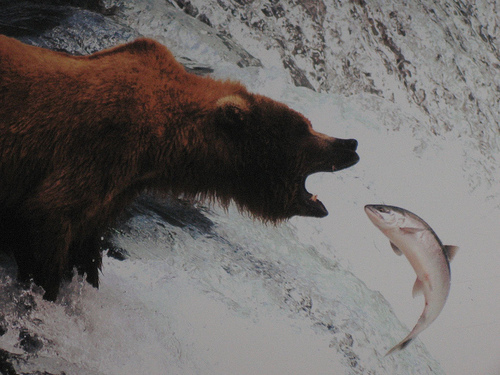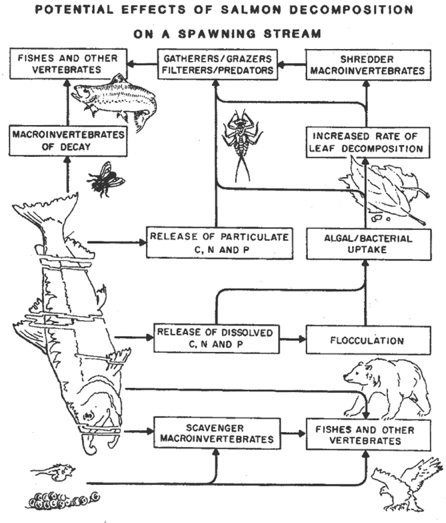Failed Feedback Loop
Part 2: Nutrient Depleted Headwaters
For their deep inland, freshwater spawning grounds, salmon are essential for the introduction of base level nutrients.
|
The Salish of British Columbia have always known that the human-salmon relationship has been fraught from the onset. Legend has it that the fish were a gift of the salmon people, a gracious, wealthy, peaceable tribe of demigods that lived across the water. Raven, the mythic trickster, kidnapped the salmon princess and spirited her back to the Salish homeland. Her outraged kin followed in hot pursuit, changing to a shimmering, hook-nosed fish form. The only way to appease the Salmon people was to return the bones of the princess and her downed kin to the river with due ceremony so that they might return to their village and regenerate.
Ever since, the annual spawning run of salmon is greeted between the Salish and other salmon catching tribes of the west coast with a ceremony returning bones to the river. Otherwise, the Salish believe, the fish would cease to return for the humans, the salmon people would wreak their revenge, and the cosmic order would be ruptured.
Ken Ashley, a published Canadian limnologist and wildlife manager, hardly looks the part of Salish shaman. In his trim, British Columbia Fish and Wildlife uniform and calm grey eyes, he is the picture of a competent bureaucrat. Yet, his prestigious new job and slick uniform are both thanks to his twenty years of research that reiterated the Salish salmon bone myth with some scientific rigor.
The bones, Ashley argues, replenish the nutrient barren inland waterways with a stock of crucial “Marine Derived Nutrients (MDNs).” Fed by rainwater and glaciers, river headwater systems lack trace elements of phosphorous, carbon and nitrogen. Though born in these sterile inland headwaters, salmon spend an average of 60-80% of their seven-year life cycle in the ocean, eating lipid and nutrient-rich upwelled plankton. Every cell in their bodies is packed with nutrients that they bring back when they spawn in their natal rivers.
|
Salmon are very connected to the system they live in. In the last section, we learned how just-hatched salmon fry time the first stages of their life cycle to arrive in time for a marine upwelling on the coast three to six months in the future and hundreds of miles away from their birthplace in headwater ecosystems. In the introduction, NOAA geneticist used his habitat fragmentation maps to demonstrate that the Chinook and Coho salmon genome closely matched the physical regional distribution of the species and therefore was determined by abiotic factors of stream flow, mountains and water temperature. The headwater spawning grounds are in turn, equally dependent on the return and presence of salmon in their system.
After returning to spawn in the headwaters where they were born, salmon die and their carcasses break down. Their decomposition nourishes the freshly hatched offspring (called alevin), as well as other animals and trees in the riparian ecosystem, nutrients that would otherwise be unavailable in the sterile snowmelt, rainwater fed watersheds. “So thorough is this nutrient redistribution system,” Ashley says, “ that deep sea isotopes of phosphorous and nitrogen have been found in Sitka spruce needles and grizzly bear fur.” Recent studies on the Olympic Peninsula’s Elwah River, show that salmon carcasses contribute to primary trophic levels of nutrients and trace elements.
“Time without geographic blockages, such as landslides, and a headstart in the region with an unthreatening predator-prey ratio allowed salmon to envelope this area completely in space and time, ” says Xanthippe Augerot who heads up Pangea LLC and is co-author of the Atlas of Pacific Salmon, a map based approach to the question of salmon preservation.
“The issues the fish are having now are caused by humans competing for the same land and resources through dams, river diversions, hatcheries, global warming and over-fishing,” says Xan Augerot, “one species against another for land.” The rate at which we are changing the environment is faster than salmon can keep up with.
What do fewer salmon mean for riparian health?

